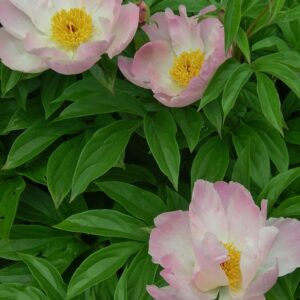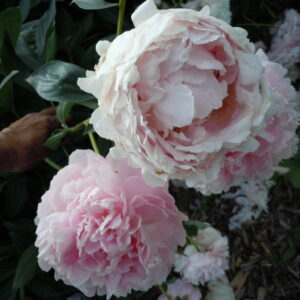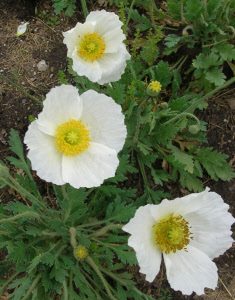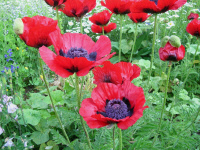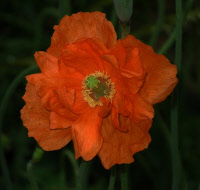Drought, Xeric & Dry Soil Plants
Showing 81–88 of 132 results
-
Paeonia ‘Seashell’ Sea Shell peony Z 3-8
Blousy, single, ballerina pink petals 6” across, surround golden centers in mid-season, sweetly fragrant.
Blousy, single, ballerina pink petals 6″ across, surround golden centers in mid-season, sweetly fragrant.
Size: 36"x 36"
Care: sun to part sun in moist well-drained soil. Plant “eyes” no deeper than 2” below soil. If planted too low, it will not flower.
Wildlife Value: Deer resistant.
Awards: American Peony Society Gold Medal in 1990.Paeonia is derived from the Greek mythical figure Paeon, who Pluto turned into a flower. Theophrastus described the peony around 300 B.C. Dioscorides, 1st century A.D., claimed the root eased the pain of childbirth. During the Middle Ages peonies used in Europe to remedy the falling sickness, cleaning women after child birth, nightmares, and melancholy. The “surest way” to effect a cure was to hang fresh root around the neck. Otherwise an infusion should be taken before and after a full moon. ‘Seashell’ introduced by H.F. Sass in 1937.
-
Paeonia ‘Butterbowl’ Peony Z 2-8
Pale pink single petals surround blousy yellow central petals, hence ‘Butterbowl.’
Pale pink single petals surround blousy yellow central petals, hence ‘Butterbowl.’ Fragrant too. Blooms midseason.
Size: 36” x 24-30”
Care: sun to part sun in fertile, moist well-drained soil. Plant “eyes” no deeper than 2” below soil. If planted too low, it will not flower.Paeonia is derived from the Greek mythical figure Paeon, physician to Pluto who cured Pluto after his defeat by Hercules. In thanks Pluto turned Paeon into a flower. Peonies have been in gardens since Greek and Roman times. ‘Butterbowl’ bred and introduced by Rosenfield, 1955.
-
Paeonia ‘Sarah Bernhardt’ Peony Z 3-8
Huge, frilly pastel pink blossoms late in the season, fragrant
Huge, frilly pastel pink blossoms late in the season, fragrant
Size: 36” x 36”
Care: sun to part shade in moist well-drained soil. Plant "eyes no deeper than 1-2" below soil level
Awards: Royal Horticultural Society Award of Merit.Paeonia is from Greek mythical figure Paeon, physician to Pluto who cured Pluto after his defeat by Hercules. In thanks Pluto turned Paeon into a flower. Peonies in gardens since ancient Greece. P. ‘Sarah Bernhardt’ introduced by French nursery Lemoine in 1906.
-
Papaver anomalum alba Z 5-9
Paper-thin petals on this pure white poppy
Paper-thin petals on this pure white poppy wth yellow stamens blooms all summer and fall – June to October, and November if it’s mild. Absolutely one of our favorites.
Size: 12” x 8”
Care: sun to part shade in moist well-drained to well-drained soil. Deer resistant
Native: European AlpsCollected by 1909.
-
Papaver bracteatum Great scarlet poppy Z 5-8
Glossy fire engine red petals with black heart
Available for purchase in Spring only
Glossy fire engine red petals with black heart in June. D.M. Ferry Catalog, 1876: ”great beauty and magnificent.”
Size: 3-4’ x 3’
Care: sun in well-drained soil. Foliage dies back in summer & reemerges in the cool autumn. Drought tolerant and deer resistant.
Native: Siberia & Northern IranPapaver bracteatum was introduced to European gardens in 1817 from its native Siberia. Poppies have been grown since at least the time when Homer wrote the Illiad, in which he used the poppy’s hanging bud as a metaphor for a dying soldier. During World War I, Canadian soldier John McCrae again united the poppy with dying soldiers. He wrote “In Flanders’ Field.”
-
Papaver orientale Poppy Z 2-7
The classic poppy - papery tabasco petals with black blotch center in June. D.M. Ferry Catalog, 1876:"great beauty and magnificent.” It dies back in summer then the leaves reappear in fall.
OUT OF STOCK
Available for purchase in Spring only
The classic poppy – papery tabasco petals with black blotch center in June. D.M. Ferry Catalog, 1876: ”great beauty and magnificent.” It dies back in summer then the leaves reappear in fall.
Size: 2-3’ x 2’
Care: Full sun in well-drained soil. Drought tolerant
Native: Caucasus
Wildlife Value: Deer resistant.Poppies have been grown since at least the time when Homer wrote the Illiad, in which he used the poppy’s hanging bud as a metaphor for a dying soldier. During World War I, Canadian soldier John McCrae again united the poppy with dying soldiers. He wrote “In Flanders’ Field.” French botanist Joseph Pitton Tournefort (1656-1708) discovered this in Armenia in 1714 and sent it to the Jardin du Roi. Tournefort wrote “the Turks eat the green heads of this Poppy, although they are very bitter and acrid.” In 1741 Englishman Peter Collinson sent seeds to John Bartram (1699-1777) who cultivated the plant in his Philadelphia nursery. Jefferson grew the oriental poppy at Monticello and Washington grew it at Mount Vernon.
-
Papaver rupifragum Spanish poppy Z 5-9
Crinkled, crepe-paper like apricot petals all summer & fall except for a recess in the heat of mid-summer.
Crinkled, crepe-paper like apricot petals all summer & fall except for a recess in the heat of mid-summer
Size: 12-18" x 8"
Care: sun in well-drained to moist well-drained soil. Deer resistant, drought tolerant
Native: Spain, Asia Minor & CaucasusFirst described in Journal of Botany in 1873. Louise Beebe Wilder considered this among her favorite perennials. (1918). One of our favorites too! Gertrude Jekyll, mother of the mixed perennial border planted this for its “rich apricot color.” (1908).
-
Parthenium integrifolium Wild Quinine Z 3-8
Frosty white blooms from July to September
Frosty white blooms from July to October, not especially showy but so reliable and sturdy, excellent. It’s a work horse.
Size: 2-4' x 18"
Care: Full sun in moist well-drained to well-drained soil. Drought tolerant.
Native: Mass. to Georgia, west Minnesota to Arkansas, Wisconsin nativeSeeds fragrant when crushed. Named Quinine because it was used to treat fevers similar to malaria. Catawabe Indians used leaves to treat burns and flowers to treat fever.

